NOMATIC McKinnon Camera Pack 35L Review
The NOMATIC McKinnon Camera Pack 35L is a professional photographer’s all-in-one backpack, and the bulky size & build deserve careful consideration.
Our Verdict
Save time. Get access to brief summaries of our reviews so you can browse and make decisions more efficiently.
Pros
- Extra durable build quality and padding ensures device protection
- Thoughtful camera compartment organization really shows
- The harness system works comfortably despite the large capacity
Cons
- Tarpaulin is known to get scratched and could mark up the bag in the future
- The front pocket is underneath a ton of weight when unpacking the camera compartment
- Size and capacity is overkill for anyone but the most kitted-out photographers
Technical Details
-
Capacity
35l
Expandable to 42L
-
Weight (lb)
5.75 lb (2.6 kg)
-
Dimensions
22 in x 13.5 in x 9 in (55.9 x 34.3 x 22.9 cm)
-
Notable Materials
Tarpaulin, Zoom Zippers, Duraflex Hardware
-
Manufacturing Country
Vietnam
-
Laptop Compartment Size
16"
-
Warranty Information
Buying Options
Full Review
Professionals and enthusiasts search for specialized gear to suit their needs all the time. For the professional photographer on-the-go, carrying all the gear necessary to take an award-winning wild-life photo or a couple’s sweetest moments is a test of endurance as much as anything else. It’s not uncommon to spot them carrying more than two bags at an airport.
So why not put everything you need into a backpack? With this idea in mind, NOMATIC has partnered up with YouTuber Peter McKinnon to create a photographer’s backpack. The result is the McKinnon Camera Pack, and it combines your travel backpack with your camera bag. But standing at a whopping 35 liters—42 liters when fully expanded—is it the right fit for most photographers, or is it a tad overkill?
Materials & Aesthetic
The McKinnon Camera Pack has a clean aesthetic that doesn’t stray too far from NOMATIC’s designs. If you squint for a bit, you can tell that this is a distant cousin of their NAVIGATOR line, with the front pocket’s chamfered lines toward the edge and extensive use of tarpaulin. Yes, this Camera Pack is a bit more busy-looking with lots more seams, lines, and garnishings, but we still see the resemblance.
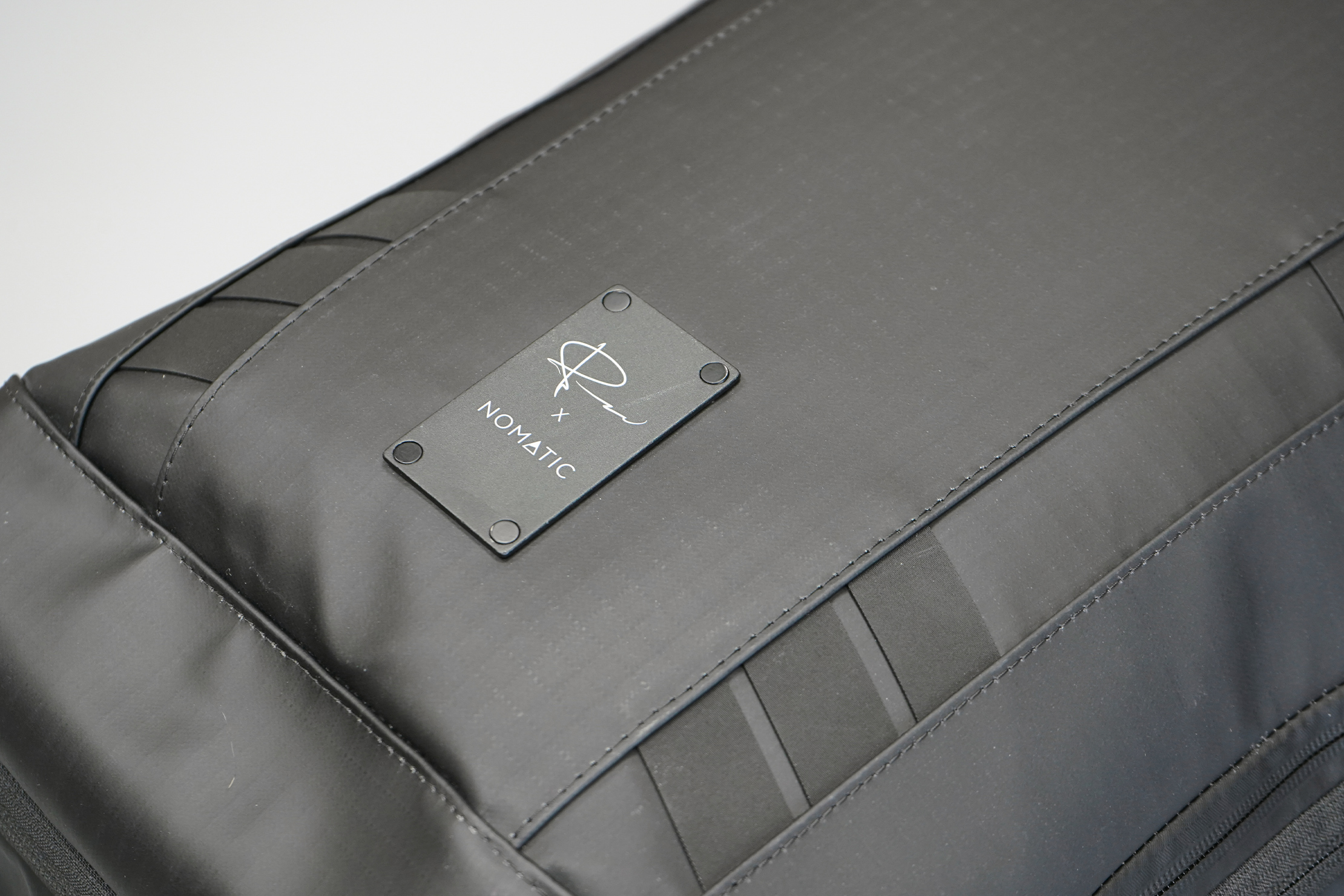
More so than the looks, we think that the bag’s size is what makes its presence more known. See the fit photos below, and the first thing you’ll notice is how this bag is the size of a medium-built torso rather than the design itself. But at least when you do get stares, people will be complimenting you on the dignified and sharp look of your backpack. Just make sure you know who Peter McKinnon is when they eventually ask about the metal badge in front of the pack and the Petes Pirate Life skull on the back panel.
As mentioned, the body is dominated by the black tarpaulin material—the only colorway available, by the way. We’ve had our fair share of experience with tarpaulin, and we’ve found it to be prone to scratches and mark-ups. However, we’ve yet to see any substantial damage on the McKinnon Camera Pack. Remember, this is a HUGE package, so there were plenty of chances for this backpack to get scuffed up during our testing. But so far, we’ve just had a minor spot on the water bottle pocket, and it’s a relatively unnoticeable one too. All that said, tarpaulin is a water-resistant material that doesn’t require any additional coating, so it’s at least mostly worry-free when it encounters the occasional spill and light shower.
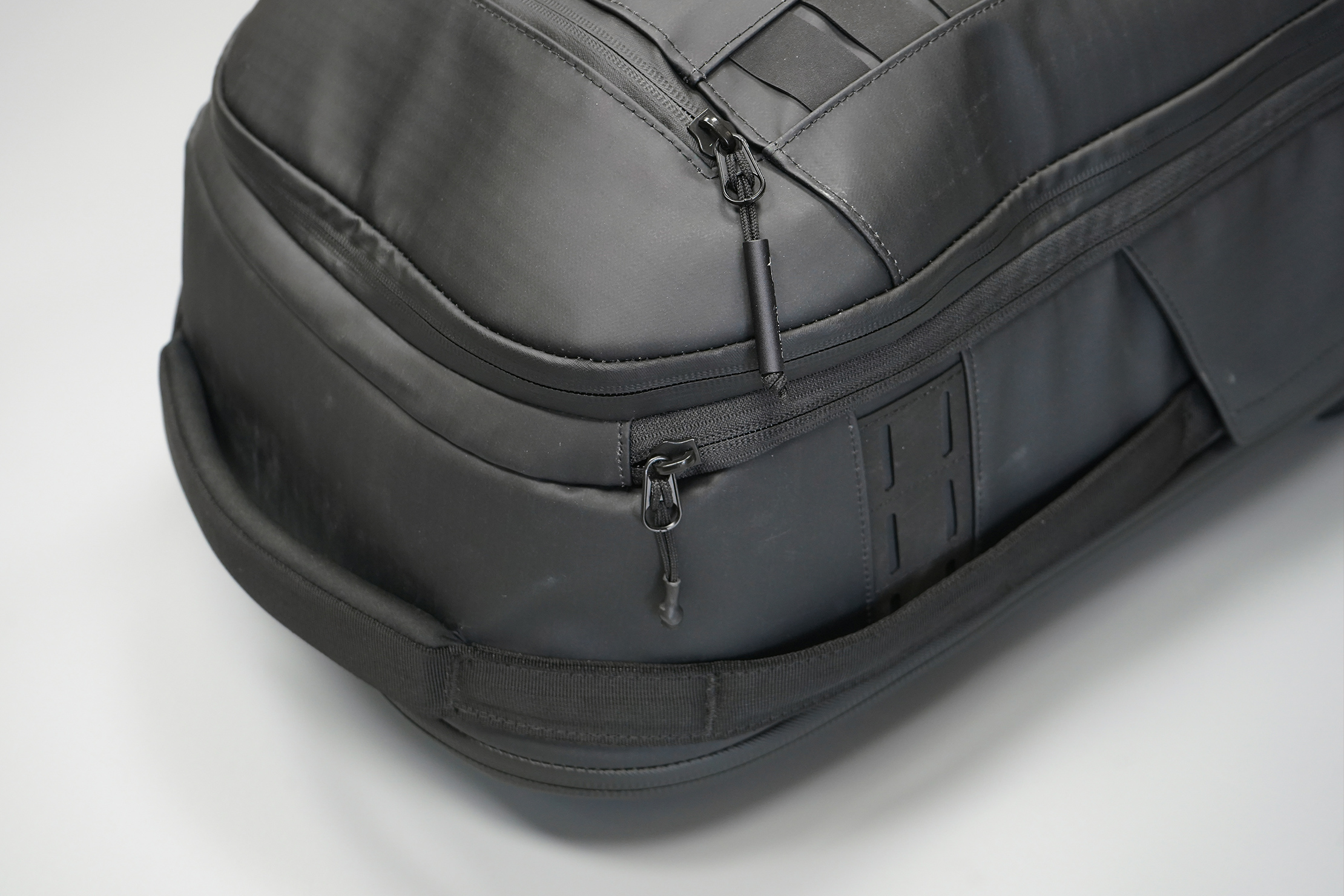
In terms of hardware, there are Zoom zippers and Duraflex for the buckles and adjusters. The package comes with a pair of removable straps with an adjuster that has a locking tab mechanism. We dig this little idea as it adds a bit more security when strapping things down.
On the other hand, the zippers can get a bit stuck on some parts along the zipper elements, particularly near the corners. But to be fair, they have to travel quite a distance given the backpack’s size. Plus, they do break-in and get smoother to use after some time. We’d imagine some of the hardcore photographers reading this right now might carry some lubricant along with them, so you can also use that to keep the zippers sliding along nicely.
External Components
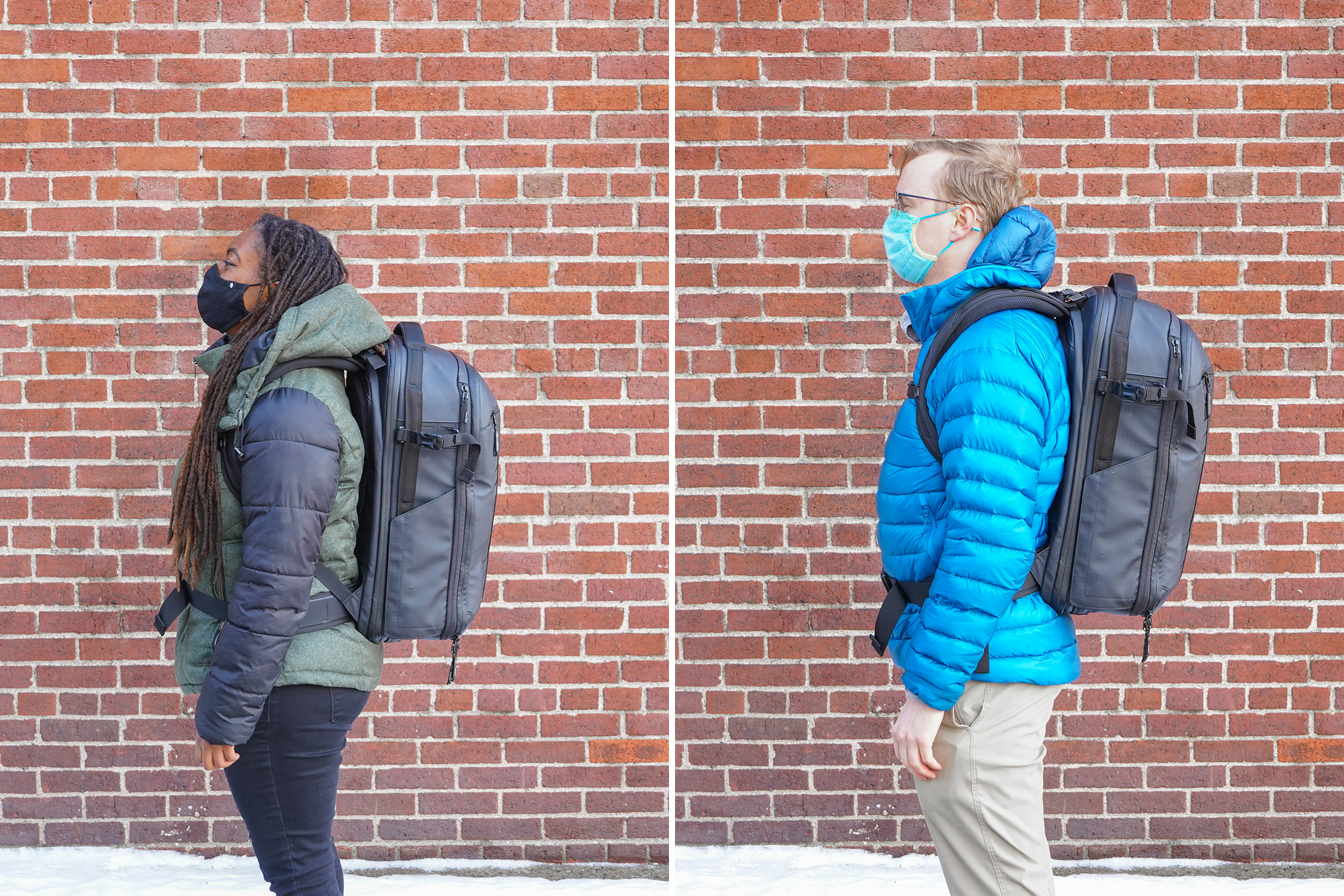
Okay, you’ve probably picked up on a recurring sentiment by this point in the review: this is one enormous backpack. It’s by no means the largest backpack we’ve wrangled onto our backs, but something about big bags really stimulates our drive to go out and make the best out of it. But we digress, and the point is that whenever we come across a big backpack, the first thing everyone wants to know is how comfortable it is to wield.
Lo and behold, a harness system befitting the title “harness system”. You got your shoulder straps, a sternum strap, and a hip belt. Before we even began to strap ourselves in, we noticed how thick these shoulder straps are. Rightfully so because of reasons you probably know by now. The top layer is the same tarpaulin material found on the rest of the body, which gives it protection from the elements, while the bottom portion is a breathable foam mesh that sits comfortably on your shoulders.
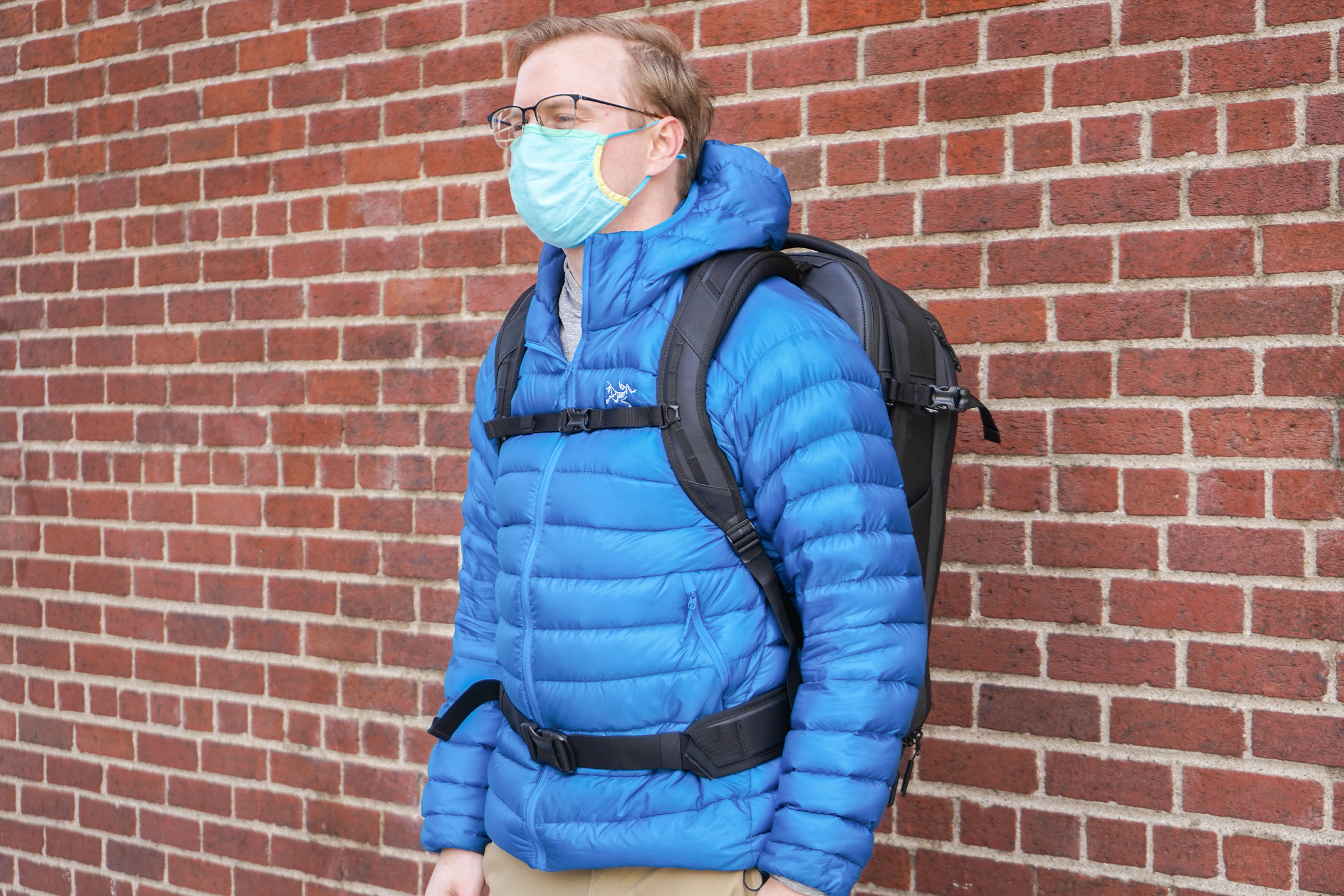
There’s also a simple sternum strap to keep things together. You have five points of top to bottom adjustment on each shoulder strap, giving you a fair degree of adjustability. They clip in easily on both sides, so you won’t have a hard time dialing in things to your liking.
The hip belt is almost as impressively well-padded as the shoulder straps. With a hip belt like this, you can almost tell the amusement park staff that you’ve brought your own roller coaster harness. Jokes aside, this belt is robust enough to carry a good amount of the load, whereas most hip belts on other travel backpacks are mostly used for balancing purposes.
To round up a well-built harness system is the well-padded back panel. It’s thick enough that we never felt any uneven bulk stemming from the interior of the back. We did find that the rather shallow air channels are, well, too shallow for our liking. With such a large surface area to work with, some deeper air channels would have made it an even more comfortable carrying experience. There’s also a rolling luggage pass-through here, but do be careful that the handle can take the load because this is a big and heavy bag once you load it up.
We’re really impressed with the harness system on the Mckinnon Camera Pack. As big as the backpack is at 35-42 liters, it never felt unwieldy to lug around, and we felt confident using it to carry thousands of dollars worth of camera equipment. In short, it’s reliable and sufficiently comfortable—all we could ask from a harness system.
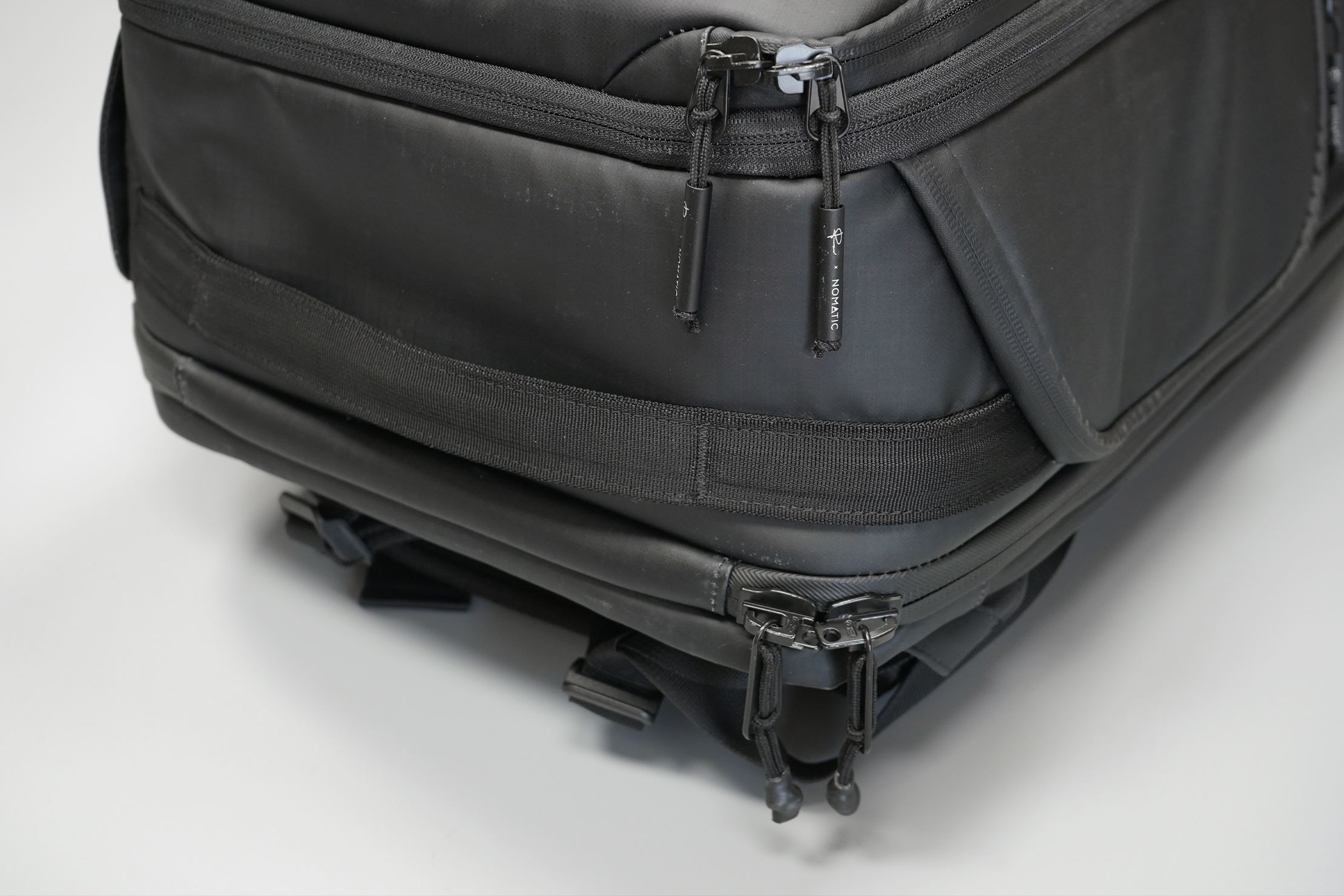
But apart from those times that you’ll be carrying the McKinnon Camera Pack on your shoulders, you’ll be pleased to know that there are also chunky handles on all four sides of the body. There’s a thick padded one at the top, along with the usual loop found between shoulder straps and two flanking ones on the top left and right. We kind of wish that the side handles are further down the body for better weight distribution, but these are fine for moving the bag across the floor. A bottom handle is also provided, and this one is probably a godsend for baggage handlers who can use this to grab onto the Camera Pack properly when they’re pulling it out of the plane’s luggage compartment.
On the subject of these side handles, the right-hand side handle can undo a part of the camera compartment’s internal velcroed divider when you really pull on it. However, the velcro eventually re-attaches itself when you set the handle down, so it didn’t cause any major issues for us.
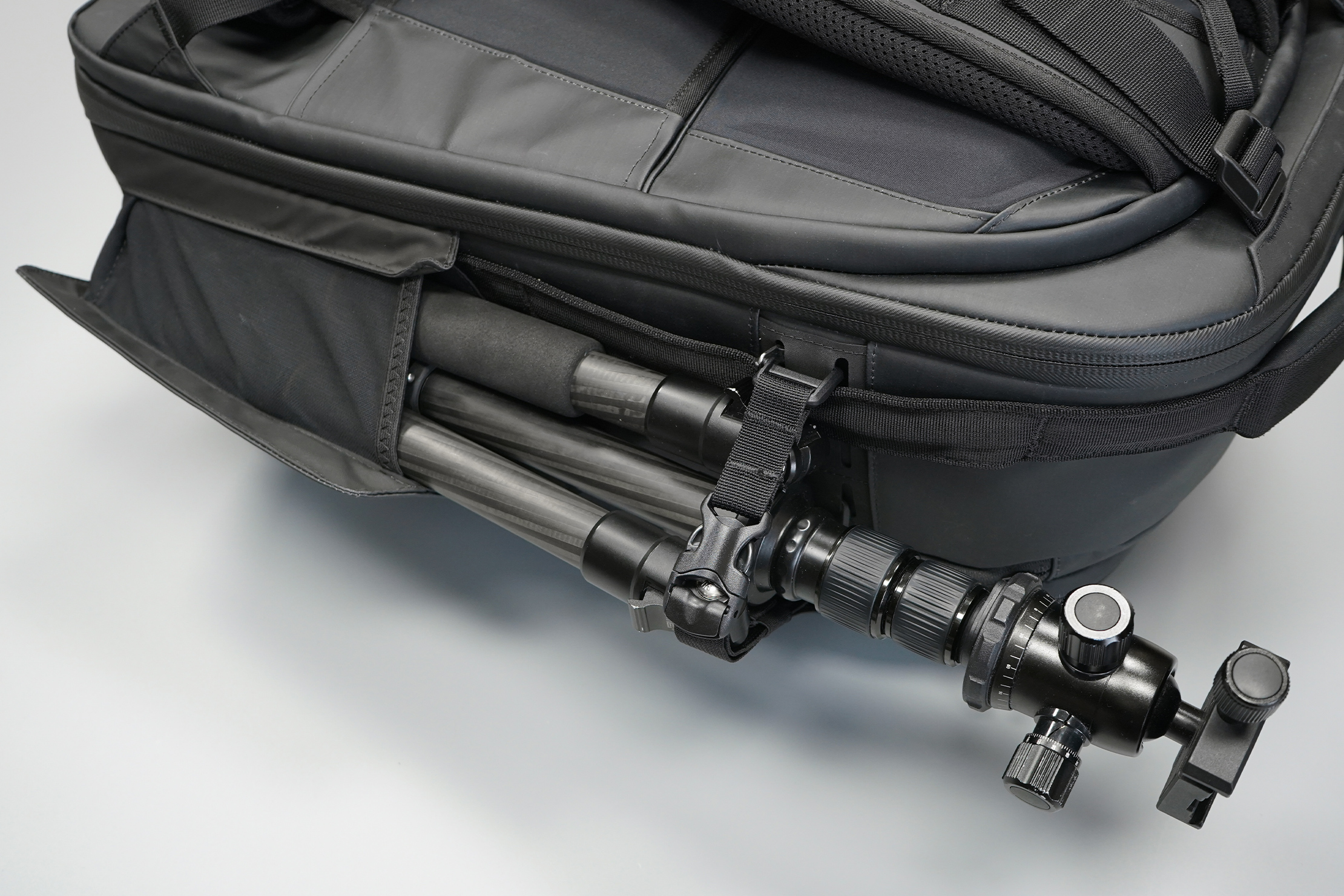
Last but not least, is the water bottle side pocket. You probably won’t notice it at first glance, but it’s there on the left-hand side; it’s just folded flat. The outer tarpaulin hides it well, but once you undo the magnetic edge, it unfolds into one super-sized bottle pocket. Our usual 21-ounce Hydro Flask suddenly looks minuscule when we placed it in there for scale.
But, being a photography-centric bag, one could argue that this pocket’s just as much about carrying a tripod as it is about carrying fluids. Indeed, it does, and this is where those pair of extra straps come in handy. They hook into the front of the bag and towards the side to act as compression straps, but they’re there mainly to hold down your tripod.
Inside The Pack
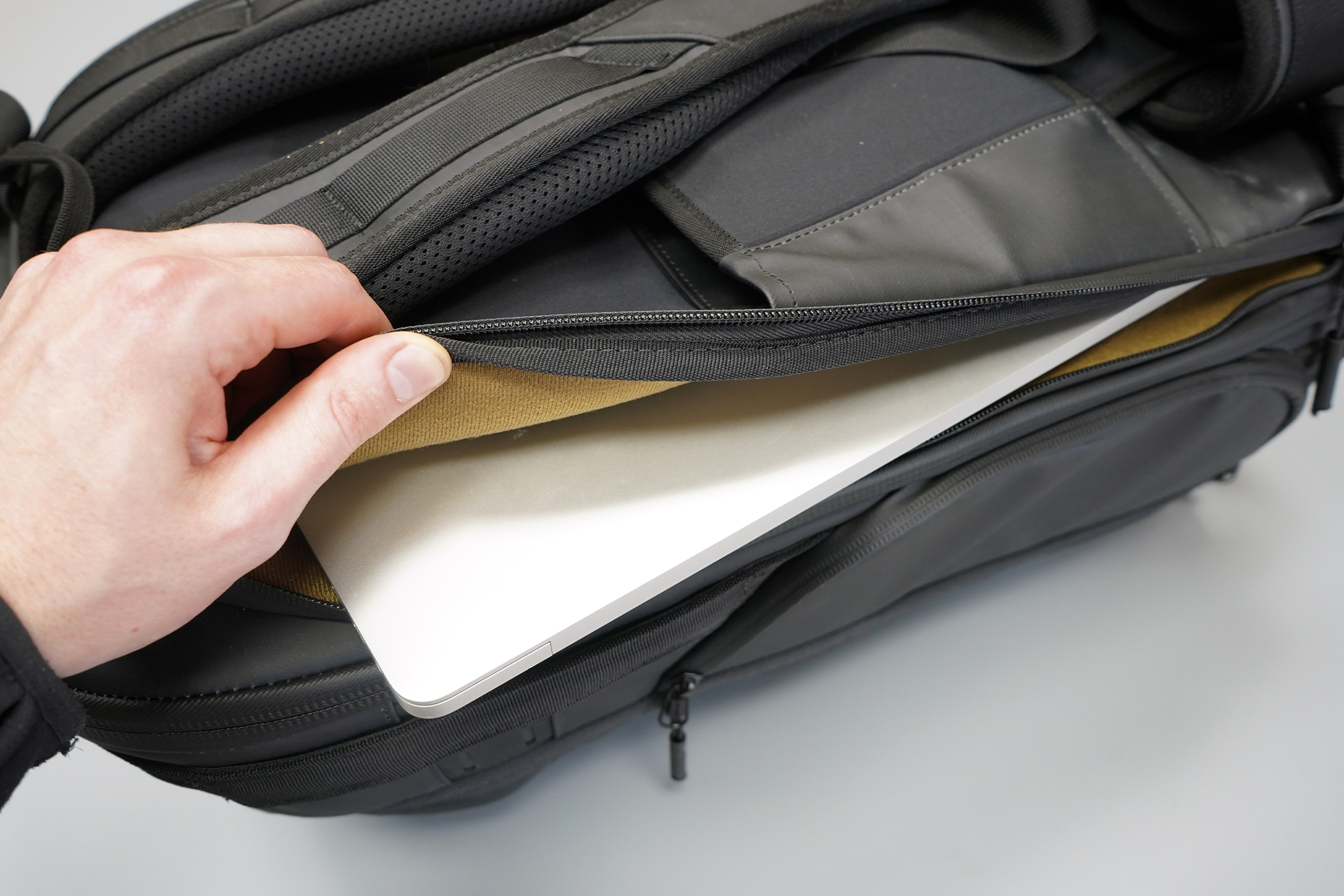
Right, time to get into the meat of things, starting with the laptop compartment. Why? Because it’s time for a periodic reminder of just how big this bag is. It opens up from the right-hand side, and we’ve put our 16-inch MacBook Pro in here and were delightfully surprised at how much buffer there is on all sides. You have your standard false bottom for sure, but you get a good inch or two on the other sides as well. That’s apart from the good amount of padding this compartment has. It’s even spacious enough for a 17-inch laptop, though thicker gaming laptops might not go in. Regardless of what laptop size you manage to get in here, you can be sure your laptop is well cared for.
From the back to the front, we come to the front pocket, and it has a party trick of its own as well. It’s adequately spacious for everyday items like your wallet, keys (it has a built-in key clip too), a bottle of hand sanitizer, and sunglasses, but it has a secret compartment for your passport too. It sits flush against the front side, its opening secured by a magnet, so it’s not noticeable to the untrained eye. It’s a neat feature, but it is a bit concerning that this front pocket will be bearing a lot of weight when the main compartments are opened up. We’d avoid putting anything fragile in this front pocket, or you can opt to use a hard case for your sunglasses if you need to put a pair in here.
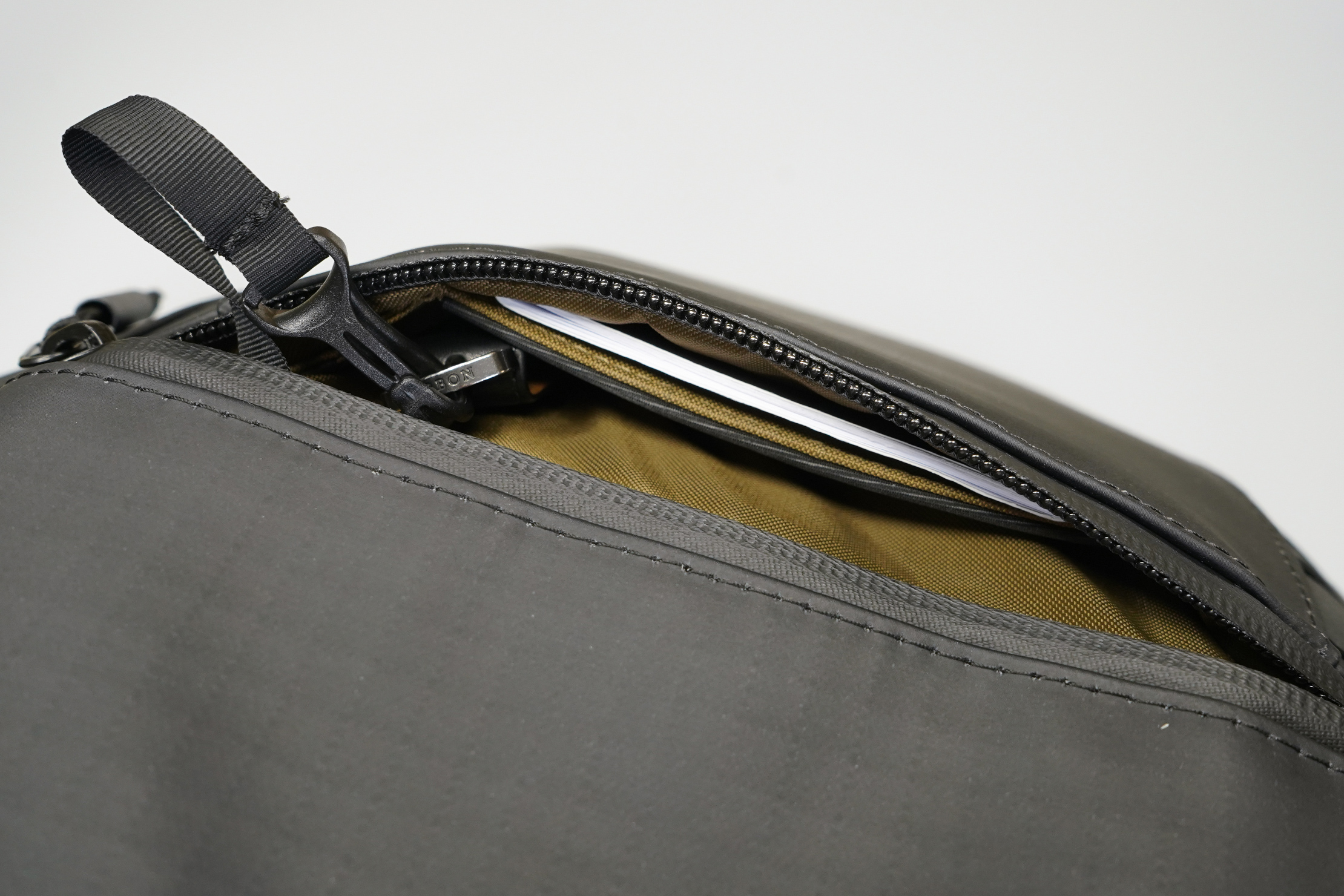
Photographers need to wear clothing too. Obvious logic, but packing enough for an off-site shoot is just as important as packing enough gear to capture the perfect moment. NOMATIC and Mr. McKinnon think so too; thus, there’s an equal amount of thought and space dedicated to the Camera Pack’s clothes compartment.
The clothes compartment opens up fully clamshell-style. On the forward-most side are two zippered mesh pockets suitable for your delicates and underwear. But wait, there’s a third zipper that runs around both these mesh pockets. Undo this zipper, and there’s more space behind it! You can put some rolled-up shirts in here that will double as extra cushioning for this side of the backpack.

But it’s on the other side where most of your clothes will go, as the hold-down straps would imply. There’s a fair bit of depth to this side thanks to this compartment’s expanding nature, which extends the Camera Pack’s 35-liter capacity up to 42 liters. Anyway, chuck in a few packing cubes in there, and you should be good for a lengthy multi-day shoot. Ah, but do be careful with the four mesh pockets on this side. These are good for toiletries, but try not to put anything leaky there, or else they might spill if they’re crushed underneath your clothes.
Finally, we come to the main event: the camera compartment. Like the clothes compartment, this section also opens up clamshell-style to reveal all your camera gear. The brown interior almost makes it seem like you’re looking into a cupboard filled with modern tech. But unlike your rigid cupboard at home, this one has all the modularity you could want in a camera bag.
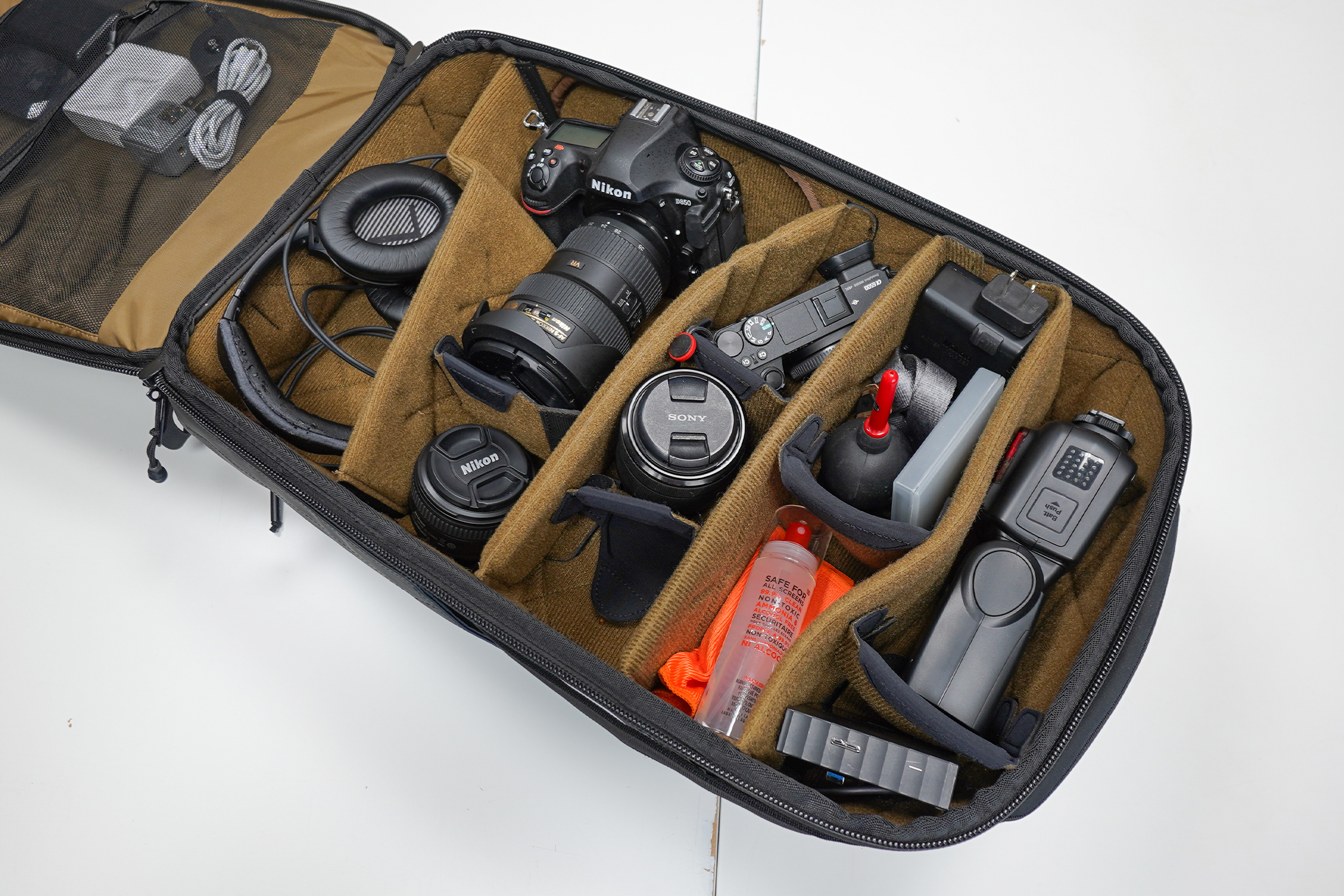
In its out-of-the-box configuration, there are four long dividers running parallel cross-wise along the interior. Five smaller dividers are also provided, which means you have exactly one small divider for the five sections in the standard configuration. You can arrange all of these pretty much however you want, but we do suggest keeping the bottom right side open and reserved for your on-hand camera.
For what reason? There’s a hatch on the bottom right side of the backpack for quick access to your camera. It’s a nice touch to remind you that this bag was co-developed with an actual photographer who knows how much quicker access to your gear means. You can, of course, just block this hatch off with one of the dividers provided if you want to trade in some convenience for extra security.
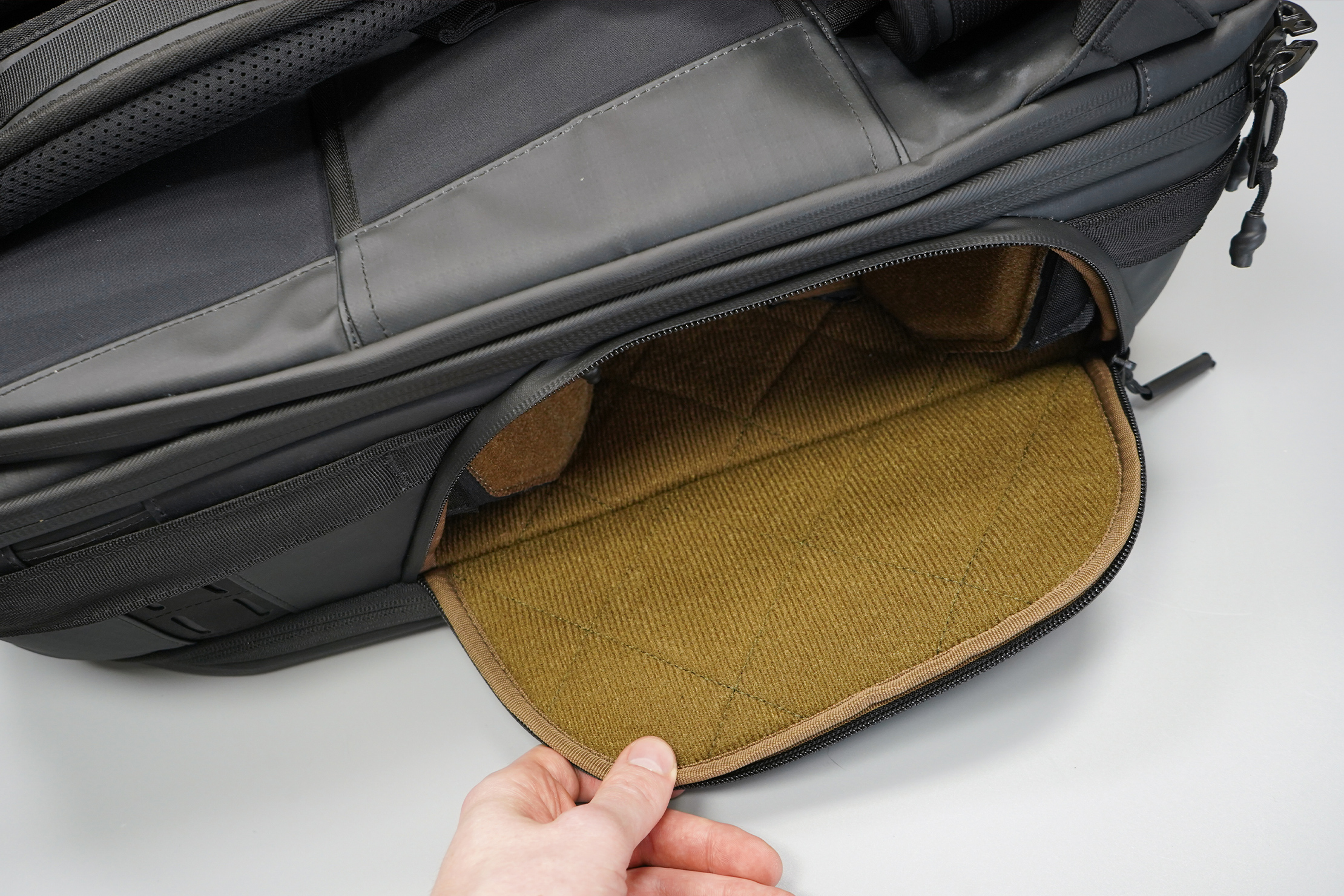
Apart from the modularity, it’s the space that really makes this such a stand-out backpack. We have a pretty extensive collection of camera gear we use at our studio, but even we had trouble filling up the camera compartment. Luckily, space is space, and if you have any extra of it left, you can always just use it for something else, like extra clothes, for example. But for the professional photographer who uses two or three camera bodies and a couple of lenses, they’d feel right at home here.
When it comes to ingesting photos and video, you’re going to want many cables and accessories to go along with your shooters. Two zippered mesh pockets are here for that, located opposite the camera sections. They’ll easily swallow up any USB cables you will need for transferring your precious stills to your computer. Thick HDMI cables can also fit in there since you never know when you need to output to an external monitor. There’s even a dedicated tablet pocket behind these mesh pockets. It’s well-padded for your peace of mind, but it can also be used as a document sleeve or even for a secondary thin and light laptop.
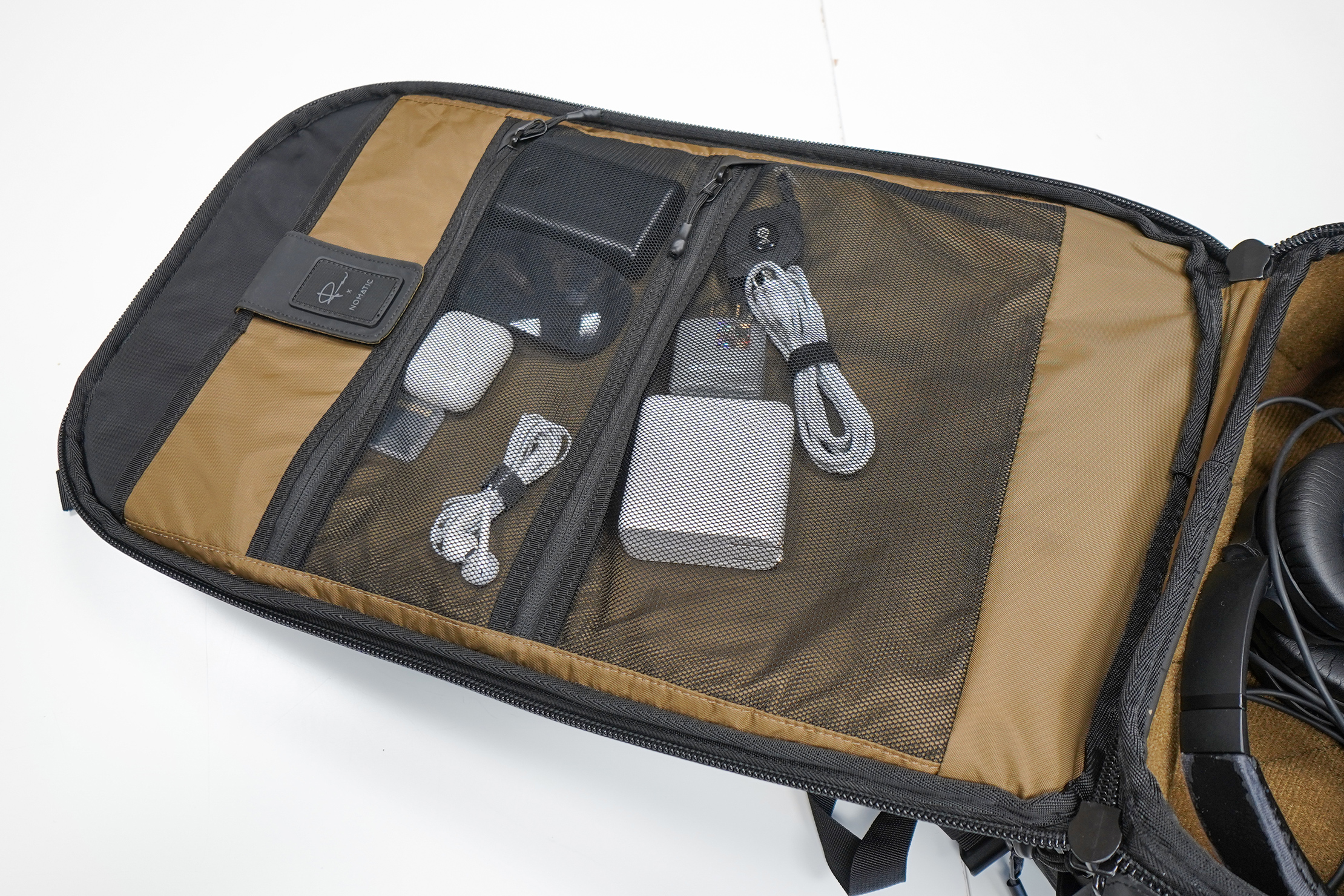
Wrap Up
That was a lot to unpack. It is a big 35-liter behemoth after all—42-liter, if we’re maxing it out—and that much capacity warrants a rich features list. What can we say? Build quality-wise, NOMATIC has definitely turned it up a notch for this one, and the McKinnon Camera Pack 35L is solidly built, relatively comfortable to carry, and has enough device protection that we’d have no qualms entrusting it with all the camera gear it can take.
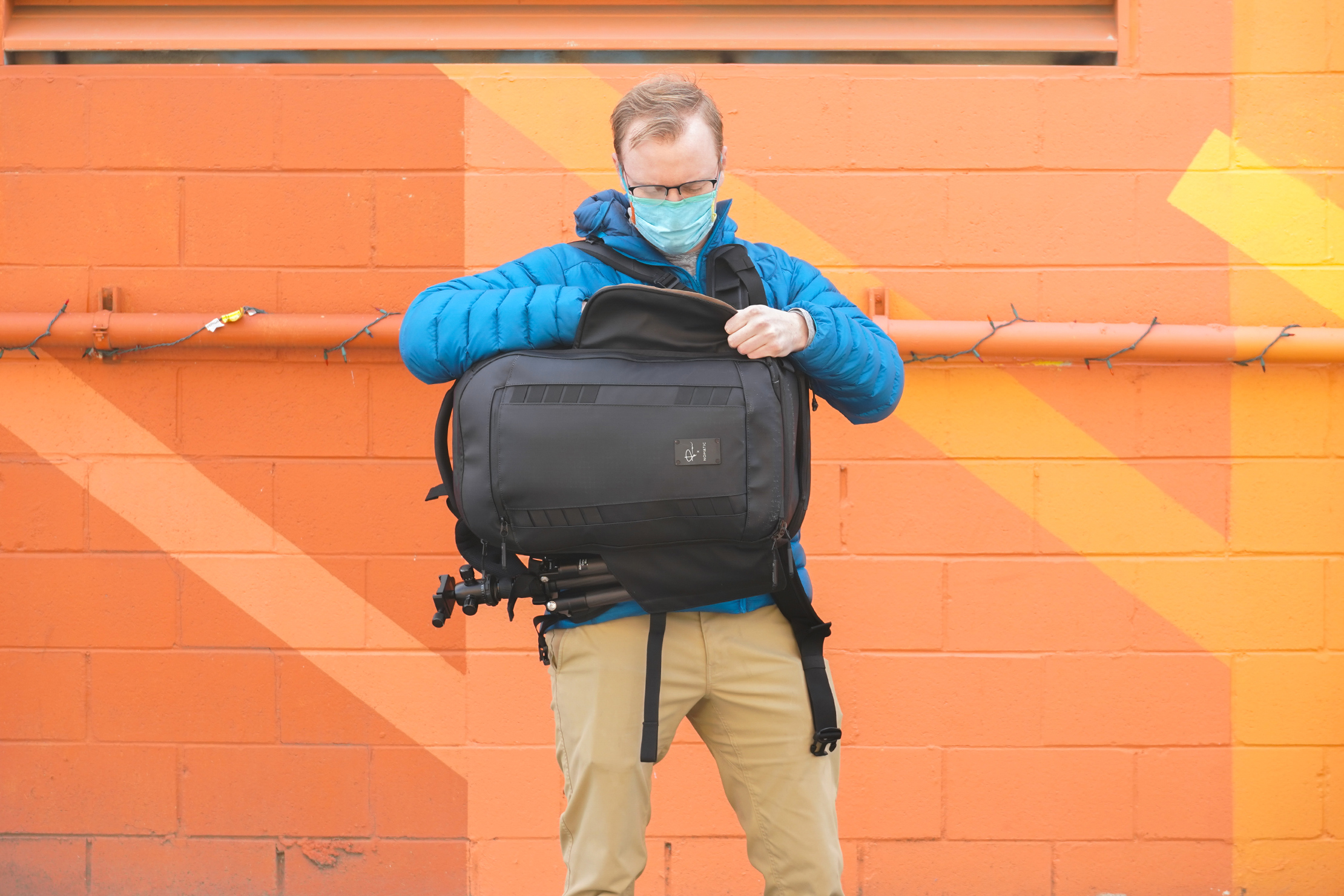
The only thing you have to worry about is bulking up the clothes compartment too much that you won’t be able to balance the bag when you’re trying to take camera gear out. And on that note, you also have to avoid putting fragile items in the front pocket, lest they be crushed under the weight of your camera gear when you’re unpacking.
The NOMATIC McKinnon Camera Pack 35L will be a bit too much for most casual digital nomads and amateur photographers. But for on-the-go professionals that live and breathe photography? They may just find this as a perfect fit.
Usage Timeline
Condition: Excellent
- Thick padding and internal structure make this bag heavy but comfortable to carry
- Most of the capacity of this bag is dedicated to camera organization
- Materials feel noticeably better than other Nomatic bags we’ve tested
Condition: Excellent
This bag is big and heavy. However, the thick back panel, shoulder straps, and hip belt all combine to help distribute the weight pretty well. Between our two DSLR cameras, two lenses, and accessories we only used about a quarter of the camera space. This bag is really made for photographers who need to carry a few larger camera bodies and a plethora of different-sized lenses. The front “clothes” space is enough space to fit a few days of clothes (when expanded), but filling this space out can make it harder to access camera gear because the bag needs to balance on this front compartment to be able to access the back camera area. While we still prefer to travel with our camera gear in a camera cube in a travel bag, this could be a great option if you carry a lot more gear than we do.



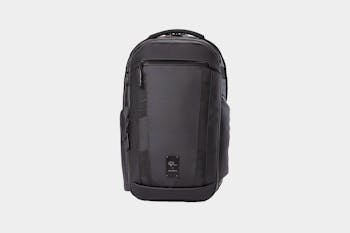






Get your questions about the NOMATIC McKinnon Camera Pack 35L answered from our team and the Pro Community right here on the page. Plus, join discussions with other members about gear, guides, and more.
Join Pack Hacker Pro or, Sign In